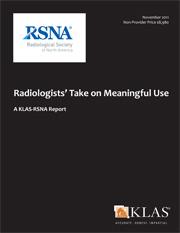
December 9, 2011 — In a new survey of 216 radiologists, nearly 40 percent of participants cited concerns about either the lack of clarity in meaningful use (MU) guidelines or decreased efficiency from adopting current MU guidelines. The study, Radiologists' Take on Meaningful Use: a KLAS-RSNA Report, features feedback from a cross section of radiologists from across the nation; those from private practice, hospital-based practice, and academic centers are all featured.
In the first report of its kind, KLAS and the Radiological Society of North America (RSNA) teamed up to uncover radiologists' major concerns regarding MU. They also wanted to discover what types of guidelines radiologists felt would be beneficial to the practice of radiology. Results of the study indicated some interesting findings.
For example, 60 percent of those surveyed either plan to or are considering qualifying for MU, and 25 percent say they are very involved in making decisions regarding MU. However, only 6 percent considered themselves to be educated regarding MU.
"These numbers should be a wakeup call for the radiology industry. Most radiologists are eligible providers — meaning that if they meet MU criteria by the deadline, they are eligible for some or all of the $44,000 incentive. In addition, those who do not meet the criteria by 2015 will be hit with penalties," said Emily Crane, KLAS research director and author of the report. "Getting educated and involved with meaningful use can't wait."
Some are concerned the current guidelines do not take radiology into consideration; so as a part of the survey, participants indicated what they felt would be beneficial to radiology. Overall, they felt clinical decision support (CDS) was important, especially for referring physicians, and saw this as a means to ensure the correct imaging test is ordered. CDS is also seen as a way to reduce the amount of unnecessary and costly imaging.
On the other hand, participants felt that radiation dose tracking and patient engagement were the least beneficial criteria. In follow-up interviews, they indicated that they feel patients have a right to their images and reports; there was, however, no apparent medical benefit or necessity for them to have electronic access.
"We hope that this feedback from radiologists can serve as a guide for the Office of the National Coordinator for HIT and those in Washington who are currently addressing Stage 2 and Stage 3 guidelines. Radiologists would like guidelines that are more appropriate for their practice of radiology," said Crane.
In addition to the questions formulated by RSNA, KLAS asked questions regarding vendor preparedness to help providers as they work to qualify for MU. The agency looked at radiology information system (RIS) and picture archiving and communications system (PACS) vendors; it found that, on average, 25 percent of respondents felt their vendor was not prepared to help them meet MU requirements.
The bottom line is radiologists need to be proactive in talking to their vendors about MU plans. More information about vendor preparedness can be found in the expanded results of the study.
For more information: www.KLASresearch.com/reports


 December 10, 2025
December 10, 2025 









